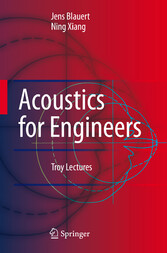Search and Find
Service
Preface
5
Contents
6
1 Introduction
9
1.1 Definition of Three Basic Terms
9
1.2 Specialized Areas within Acoustics
11
1.3 About the History of Acoustics
12
1.4 Relevant Quantities in Acoustics
13
1.5 Some Numerical Examples
14
1.6 Levels and Logarithmic Frequency Intervals
16
1.7 Double-Logarithmic Plots
18
2 Mechanic and Acoustic Oscillations
20
2.1 Basic Elements of Linear, Oscillating, Mechanic Systems
21
2.2 Parallel Mechanic Oscillators
23
2.3 Free Oscillations of Parallel Mechanic Oscillators
24
2.4 Forced Oscillation of Parallel Mechanic Oscillators
26
2.5 Energies and Dissipation Losses
29
2.6 Basic Elements of Linear, Oscillating, Acoustic Systems
31
2.7 The Helmholtz Resonator
32
3 Electromechanic and Electroacoustic Analogies
33
3.1 The Electromechanic Analogies
34
3.2 The Electroacoustic Analogy
35
3.3 Levers and Transformers
35
3.4 Rules for Deriving Analogous Electric Circuits
37
3.5 Synopsis of Electric Analogies of Simple Oscillators
39
3.6 Circuit Fidelity, Impedance Fidelity and Duality
39
3.7 Examples of Mechanic and Acoustic Oscillators
40
4 Electromechanic and Electroacoustic Transduction
42
4.1 Electromechanic Couplers as Two- or Three-Port Elements
43
4.2 The Carbon Microphone – A Controlled Coupler
44
4.3 Fundamental Equations of Electroacoustic Transducers
45
4.4 Reversibility
48
4.5 Coupling of Electroacoustic Transducers to the Sound Field
49
4.6 Pressure and Pressure-Gradient Receivers
51
4.7 Further Directional Characteristics
54
4.8 Absolute Calibration of Transducers
57
5 Magnetic-Field Transducers
59
5.1 The Magnetodynamic Transduction Principle
61
5.2 Magnetodynamic Sound Emitters and Receivers
63
5.3 The Electromagnetic Transduction Principle
69
5.4 Electromagnetic Sound Emitters and Receivers
71
5.5 The Magnetostrictive Transduction Principle
72
5.6 Magnetostrictive Sound Transmitters and Receivers
73
6 Electric-Field Transducers
74
6.1 The Piezoelectric Transduction Principle
74
6.2 Piezoelectric Sound Emitters and Receivers
77
6.3 The Electrostrictive Transduction Principle
81
6.4 Electrostrictive Sound Emitters and Receivers
82
6.5 The Dielectric Transduction Principle
83
6.6 Dielectric Sound Emitters and Receivers
84
6.7 Further Transducer and Coupler Principles
88
7 The Wave Equation in Fluids
90
7.1 Derivation of the One-Dimensional Wave Equation
92
7.2 Three-Dimensional Wave Equation in Cartesian Coordinates
96
7.3 Solutions of the Wave Equation
98
7.4 Field Impedance and Power Transport in Plane Waves
99
7.5 Transmission-Line Equations and Re.ectance
100
7.6 The Acoustic Measuring Tube
102
8 Horns and Stepped Ducts
105
8.1 Webster’s Differential Equation – the Horn Equation
106
8.2 Conical Horns
107
8.3 Exponential Horns
110
8.4 Radiation Impedances and Sound Radiation
112
8.5 Steps in the Area Function
113
8.6 Stepped Ducts
115
9 Spherical Sound Sources and Line Arrays
118
9.1 Spherical Sound Sources of 0th Order
119
9.2 Spherical Sound Sources of 1st Order
123
9.3 Higher-Order Spherical Sound Sources
125
9.4 Line Arrays of Monopoles
126
9.5 Analogy to Fourier Transforms as Used in Signal Theory
128
9.6 Directional Equivalence of Sound Emitters and Receivers
131
10 Piston Membranes, Diffraction and Scattering
133
10.1 The Rayleigh Integral
134
10.2 Fraunhofer’s Approximation
135
10.3 The Far Field of Piston Membranes
136
10.4 The Near Field of Piston Membranes
138
10.5 General Remarks on Diffraction and Scattering
142
11 Dissipation, Re.ection, Refraction, and Absorption
145
11.1 Dissipation During Sound Propagation in Air
147
11.2 Sound Propagation in Porous Media
148
11.3 Reflection and Refraction
151
11.4 Wall Impedance and Degree of Absorption
152
11.5 Porous Absorbers
155
11.6 Resonance Absorbers
158
12 Geometric Acoustics and Diffuse Sound Fields
161
12.1 Mirror Sound Sources and Ray Tracing
162
12.2 Flutter Echoes
165
12.3 Impulse Responses of Rectangular Rooms
167
12.4 Di.use Sound Fields
169
12.5 Reverberation-Time Formulae
172
12.6 Application of Diffuse Sound Fields
173
13 Isolation of Air- and Structure-Borne Sound
177
13.1 Sound in Solids – Structure-Borne Sound
177
13.2 Radiation of Airborne Sound by Bending Waves
179
13.3 Sound-Transmission Loss of Single-Leaf Walls
181
13.4 Sound-Transmission Loss of Double-Leaf Walls
184
13.5 The Weighted Sound-Reduction Index
186
13.6 Isolation of Vibrations
189
13.7 Isolation of Floors with Regard to Impact Sounds
192
14 Noise Control – A Survey
194
14.1 Origins of Noise
195
14.2 Radiation of Noise
195
14.3 Noise Reduction as a System Problem
199
14.4 Noise Reduction at the Source
202
14.5 Noise Reduction Along the Propagation Paths
203
14.6 Noise Reduction at the Receiver’s End
207
15 Appendices
209
15.1 Complex Notation for Sinusoidal Signals
209
15.2 Complex Notation for Power and Intensity
210
15.3 Supplementary Textbooks for Self Study
212
15.4 Letter Symbols, Notations and Units
213
Index
217
All prices incl. VAT













